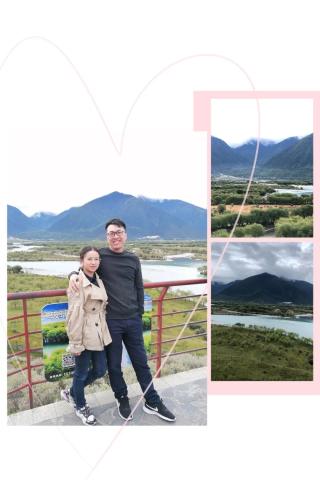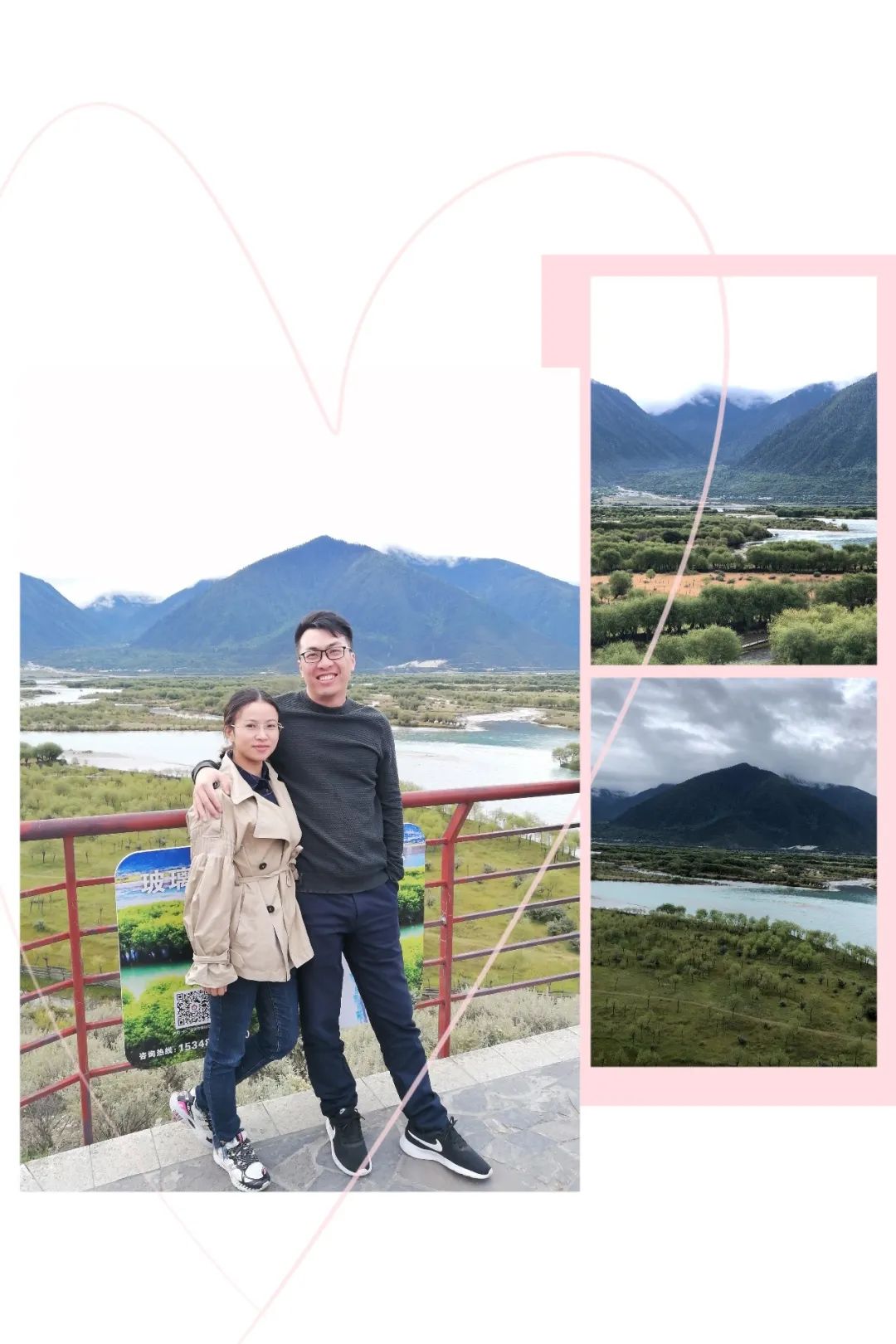
01——Niyang River Scenic Belt
Today's trip is relatively easy, the drive is relatively short, and the temperature is relatively suitable. The most important thing is that there is no high-reflection today, and the journey is over.
We set off at 8 o'clock in the morning, and our first stop was the Niyang River Scenic Area. We stood on the glass viewing platform and watched the scenery of the Niyang River. The green river water and the white blue sky were very beautiful.
When we looked at it at a glance, looking at the water, the mountains, and the trees, we no longer had the impetuousness of the past, and just immersed ourselves in the natural scenery. The enthusiastic group members also took a group photo for us, and also There were secretly taken photos of people "showing affection".

02——Yarlung Zangbo Grand Canyon
At noon we came to the Yarlung Zangbo Grand Canyon, which is the deepest canyon on earth. Standing at the top of the mountain, we can see the snow-capped mountains. The scenery of the snow-capped mountains is very beautiful. The mountains are vaguely visible in the white mountains. After a while, white clouds came and covered the mountain. All we could see were white clouds floating in the sky.
When we walked up from the foot of the mountain, we took a bus all the way along the winding mountain road to visit one scenic spot after another. Although each scenic spot is small, it has its own flavor. We stood at the best viewing place to look at the Yarlung Zangbo Grand Canyon, looking up and enjoying the scenery all the way.
Along the way, there were lovely group friends to take photos with and see the scenery together. No more work, no more worries, and now I just enjoy the road in Tibet.

03——Nanyigou
At around 3 o'clock, we drove to another scenic spot - Nanyigou. In the poem "Visiting Nanyigou" by the poet Wang Xinjian, he said: "The clear stream disturbs the tranquility, and the ancient village is in the mountains. White clouds connect to the snow ridges, and rainbows guard the flower fields. The path There are many birds, but few people speak in the deep forest. The pure land calms down the dust, and this is a paradise." The poem praises the beautiful scenery of Nanyigou.
It is true that we took the open "sports car" along the way, stopped and went, and passed 3 scenic spots. The first scenic spot was to see the rapid water, clear water, gentle wind, and feel the pristine water and mountains. The second attraction was to see the virgin forest, walk for a short distance, and feel the primitive natural state. Finally, we came to the third scenic spot, which was about 1.0 kilometers away. We walked on the road made of wood. Along the way, we saw many large trees that had been cut down and fell in the bushes. It was a pity.
You will see many trees growing tall and straight. Why do they grow so straight? Because they need to absorb more nutrients. They must grow taller and straighter than other trees in order to absorb limited amounts of nutrients. of sunlight and oxygen.
This is the law of survival in nature, and in fact it is also the law of survival for us humans. If we want to live a good life, we must work hard to do better in order to obtain better resources.
Our third day of Tibet trip ends here, and the enjoyment for our eyes is very satisfying. In addition to the satisfaction of the eyes, of course, our tour guide Huahua, who has many stories and rich history, explains and introduces Tibetan culture.

04 About the Soul—The Reincarnation of the Living Buddha
Today we mainly talk about the reincarnation of the Panchen Lama and the Dalai Lama.
This starts with the soul. Is there really a soul in this world? After death, will the soul be reincarnated as a human being? There are two experiments about the soul, one is the ceiling experiment of the soul and the other is the experiment of the weight of the soul. If you are interested in these two experiments, you can search them on Baidu.
I am not sure about the soul, but I have had such an experience in life. When it is quiet at night, I sit alone in the living room reading a book or doing something, and I always feel like there is a shadow following me behind me. I can't help but want to look back, including when I am writing today's travel diary, I feel like there is a pair of eyes behind me looking at me, and I can't help but look back.
Tour guide Huahua said that this is our soul, and when our yang energy is insufficient, our soul will appear, just like the soul ceiling experiment.
So why talk about the soul? This is because whether it is the Panchen Lama or the Dalai Lama, after their death there will be a Panchen Lama and a Dalai Lama in the next life. So how to find the Panchen Lama and Dalai Lama in the next life?
This requires 5 characteristics to find?
The first one is that according to their last words during their lifetime, it will reveal some circumstances about their birth after reincarnation. According to their last words, we can find the next Panchen Lama or Dalai Lama.
The second is time. To determine a point in time, we need to find children born within one year.
The third step is to determine the location. When they pass away, there will be a reminder of their geographical location, so you have to look for them based on their geographical location.
The fourth is divination, allowing the living Buddha to divine.
The fifth is to watch movies. You go to a specific lake to perform a movie viewing ceremony, and you are given a lot of sacrifices, grains, rare treasures, gold and silver jewelry, and then a miracle occurs. Finally, you find the reincarnated Panchen Lama or the Dalai Lama. Only by comparing whether they are consistent can you determine whether it is the Panchen Lama or the reincarnation of the Dalai Lama.
Today’s content talks about the reincarnation of the Living Buddha, which is also a religious belief in Tibet. Tibetans live a very simple life materially, but they are very rich spiritually. They have their own beliefs. I believe in cultivating the next life in this life, so if you live a good life in this life, you can also have a good life in the next life.
05 View of Cause and Effect
Here we talk about the concept of cause and effect. Today’s cause is tomorrow’s country, and today’s effect is the cause of the past. The cycle of cause and effect repeats. Don’t get rid of ostomy karma, body karma, and mental karma. Therefore, it is said that you can do good deeds within your ability and accumulate merit. Merit is divided into Yin virtue and Yang virtue. Yin virtue is when you do good deeds secretly, and Yang virtue is when you do good deeds and publicize them everywhere or let others know about them.
For us, we may often commit verbal karma, saying bad things about others behind their backs, saying hurtful words to our loved ones, saying sarcastic words to others, etc. Therefore, it is a great accomplishment to keep your mouth shut and not to have ostomy karma.
Tour guide Huahua also talked about Tibet’s view of life and death, which really touched me. I still remember that my mother was in a lot of pain when she passed away. She had abdominal distension and a lot of ascites after gastric cancer. She couldn't eat well and couldn't sleep well. She lost a lot of weight. This is leaving with pain, and it shows how much sin you have suffered.
For Tibetans, they are very calm in the face of life and death. Today's physical death is for reincarnation in the next life, so they will tell the patient the truth according to his condition, and everyone will accompany their loved ones to spend the last days of their lives.
I remember what the Four Precepts said: people have five blessings: longevity, wealth, health, good virtue, and a good death. A good death means dying without illness, which is the greatest blessing for a person.
In the face of life and death, none of us can control it. All we can do is live in the present, plant good causes🉐️good fruits, accumulate virtue, do good deeds, and accumulate blessings for ourselves and our families.
So back to why I came to Tibet, I don’t know, but I know what I feel and gain at the moment? Find the pure world view and values in your heart, live in the present, and plant good causes for good.
